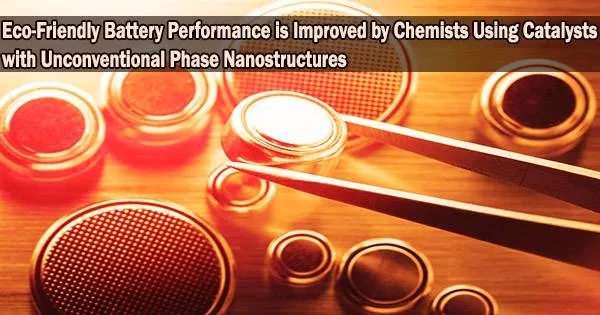Although the metal-carbon dioxide battery is a promising and eco-friendly technology, it only has a modest level of energy efficiency. By using an atypical phase nanomaterial as a catalyst, a research team recently lead by chemists from City University of Hong Kong (CityU) found a creative solution to this issue, increasing battery energy efficiency by up to 83.8%.
The research offers a brand-new catalyst design for the next generation of meta-gas batteries that can help achieve carbon neutrality objectives.
The metal-carbon dioxide battery enables carbon dioxide (CO2) fixation without additional energy consumption from an external circuit to transform CO2 greenhouse gas emissions into value-added goods while also supplying electronics with long-lasting electricity (high energy density).
A strong choice for the next generation of high-performance energy conversion and storage technology is the lithium-carbon dioxide battery, which has a high theoretical energy density (1876 Wh kg-1) and is thus very advantageous.
However, metal-CO2 batteries still suffer from sluggish reaction kinetics. This results in a significant over-potential, low energy efficiency, poor reversibility, and inadequate cycling stability (more voltage or energy is needed than is theoretically estimated to drive the oxidation-reduction mechanism that makes the battery run).
Researchers commonly consider morphology, size, constituents, and distribution of metal-based components in composite cathode catalysts to be the main concerns that lead to differences in battery performance.
Dr. Fan Zhanxi
Technical hurdles in traditional catalyst modification strategies
“Researchers commonly consider morphology, size, constituents, and distribution of metal-based components in composite cathode catalysts to be the main concerns that lead to differences in battery performance,” said Dr. Fan Zhanxi, Assistant Professor in the Department of Chemistry at CityU, and one of the leaders of the study.
“But we found preparing novel catalysts with unconventional phases to be a feasible and promising strategy to boost the energy efficiency and performance of metal-gas batteries, especially since traditional modification strategies for catalysts have encountered long-term technical hurdles.”
Dr. Fan and his team accumulated extensive experience and knowledge related to the precise regulation of the crystal phase of metal-based nanomaterials, which enabled them to select suitable elements to construct their unconventional phases and subsequently study the effect of the crystal phase of catalysts on the reaction kinetics of a certain kind of aprotic (i.e., not involving hydrogen ions) metal-gas electrochemistry.
“However, this does not mean that this process is easy to realize because it involves strict requirements on the bifunctionality of cathode catalysts in an organic environment,” explained Dr. Fan.
The researchers controlled the development kinetics of Ir on gold (Au) templates to produce iridium nanostructures with an unusual 4H/face-centered cubic (fcc) heterophase. In comparison to other metal-based catalysts (typically with charge potential of over 3.8 V and energy efficiency up to 75%), the catalyst with 4H/fcc heterophase in their experiments showed a lower charge plateau (below 3.61 V) and higher energy efficiency up to 83.8% during cycling in aprotic Li-CO2 batteries.
Outstanding performance of unconventional phase metal nanomaterials
The team’s tests and theoretical calculations showed that phase-engineered 4H/fcc Ir nanostructures are better suited for the reversible generation of amorphous/low-crystalline discharge products, lowering the overpotential and enhancing the cycling stability of electrochemical redox processes.
When compared to other published metal-based catalysts employed in aprotic Li-CO2 batteries, the unique phase 4H/fcc Ir nanostructures performed significantly better than typical fcc Ir and exhibited remarkable charge potential and energy efficiency.
“This study reveals the great potential of phase engineering of catalysts in metal-gas electrochemistry. It opens up a new direction to design catalysts for developing sustainable electrochemical energy conversion and storage systems,” concluded Dr. Fan.
The first authors are Mr. Zhou Jingwen and Dr. Liao Lingwen, from CityU, Dr. Wang Tianshuai from The Hong Kong University of Science and Technology (HKUST), and Mr. Chen Lin from China Academy of Engineering Physics (CAEP). The corresponding authors are Dr. Fan Zhanxi, from CityU, Professor Zhao Tianshou, from HKUST, Professor Gu Lin, from the Institute of Physics at the Chinese Academy of Sciences, and Professor Cheng Jianli, from CAEP. Other CityU team members include Professor Lee Chun-Sing, Dr. Chen Bo, Dr. Guan Zhiqiang, and a group of PhD students from the Department of Chemistry.
The key funding sources were the National Natural Science Foundation of China (NSFC), the Innovation and Technology Commission (ITC) of Hong Kong, the Hong Kong Branch of the National Precious Metals Material Engineering Research Center (NPMM), and CityU.





